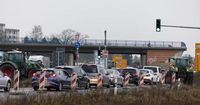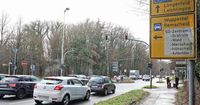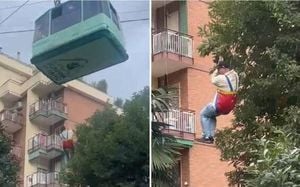Traffic congestion is a growing concern across several regions in Germany, as new construction projects and accidents contribute to delays on major roads. Recent traffic reports from Celle, Nienburg, and Solingen reveal significant bottlenecks that drivers should be aware of, particularly as the spring travel season approaches.
In Celle, traffic updates indicate that several routes are experiencing slower-than-usual conditions. According to the latest report published on April 9, 2025, major traffic bottlenecks include the Bundesstraße 3 (B3) towards Hannover and Soltau, Bundesstraße 214 (B214) towards Braunschweig and Schwarmstedt, and Bundesstraße 191 (B191) towards Uelzen. Additionally, the Wilhelm-Heinichen-Ring in Celle is currently under construction, leading to further delays. The data for these updates is sourced from TomTom, which utilizes GPS data from millions of devices and updates information every five minutes to ensure accuracy.
Meanwhile, the situation in Nienburg is similarly challenging. The traffic report from the same date highlights congestion on key routes including the Autobahns A2, A37, A7, A27, and A1, as well as several Bundesstraßen such as B6, B215, B214, B482, B62, B239, B51, B442, and B441. Like Celle, Nienburg relies on TomTom for its traffic data, which is also updated in real-time to keep drivers informed of any changes.
In Solingen, the traffic situation is particularly severe, with the ADAC (German Automobile Club) noting that the A3 between Cologne and Oberhausen was the most congested stretch in North Rhine-Westphalia in 2023, accumulating over 10,000 hours of traffic jams. This route is critical for commuters traveling to and from the region, especially with ongoing construction at the A3 Solingen junction exacerbating delays. The A46, connecting Düsseldorf and Wuppertal, is also a known bottleneck, while the A1 has seen nearly 6,500 hours of traffic jams between Cologne and Dortmund.
Drivers in Solingen must be cautious on several important roads, including the B229, which runs through the city and connects to Remscheid, and the B224, linking Solingen-Mitte with Wuppertal-Vohwinkel. Other key routes include Landesstraßen L74 and L357, as well as various local streets that are vital for daily commutes.
As traffic congestion continues to be an issue, authorities urge drivers to remain patient and considerate towards other road users. For those planning to travel through these regions, it is advisable to check real-time traffic updates and consider alternative routes to avoid delays.
The reliance on advanced technology, such as GPS data from TomTom, plays a crucial role in providing accurate and timely traffic information. With the integration of data from approximately 80 million mobile devices and several million government road sensors, the reports aim to keep drivers informed and safe.
In summary, the traffic landscape in Celle, Nienburg, and Solingen is marked by significant delays due to construction and accidents. As the spring season approaches, drivers are encouraged to stay updated on traffic conditions and plan their routes accordingly. By taking these precautions, they can help alleviate some of the congestion and ensure safer travel for everyone on the road.






